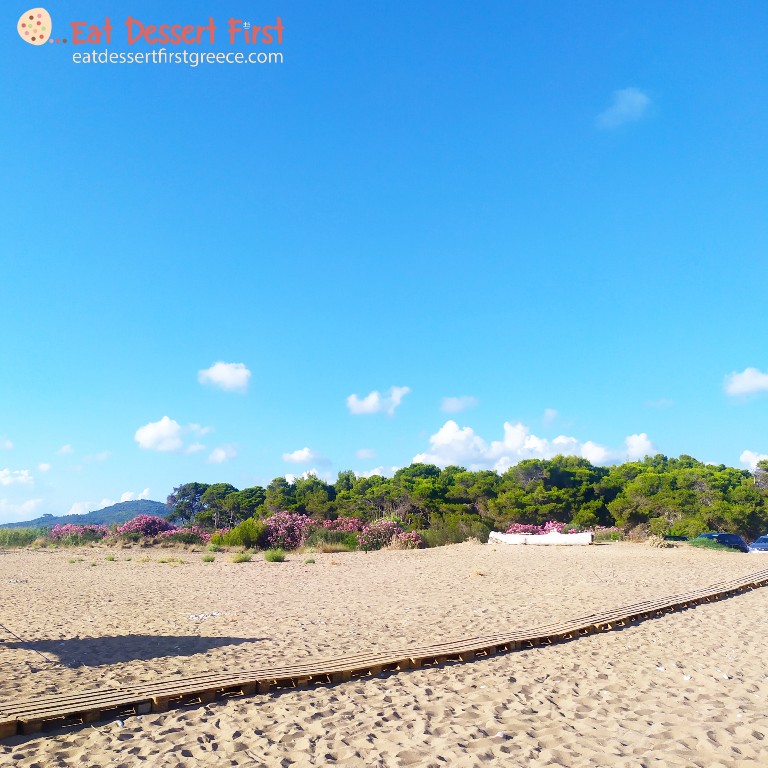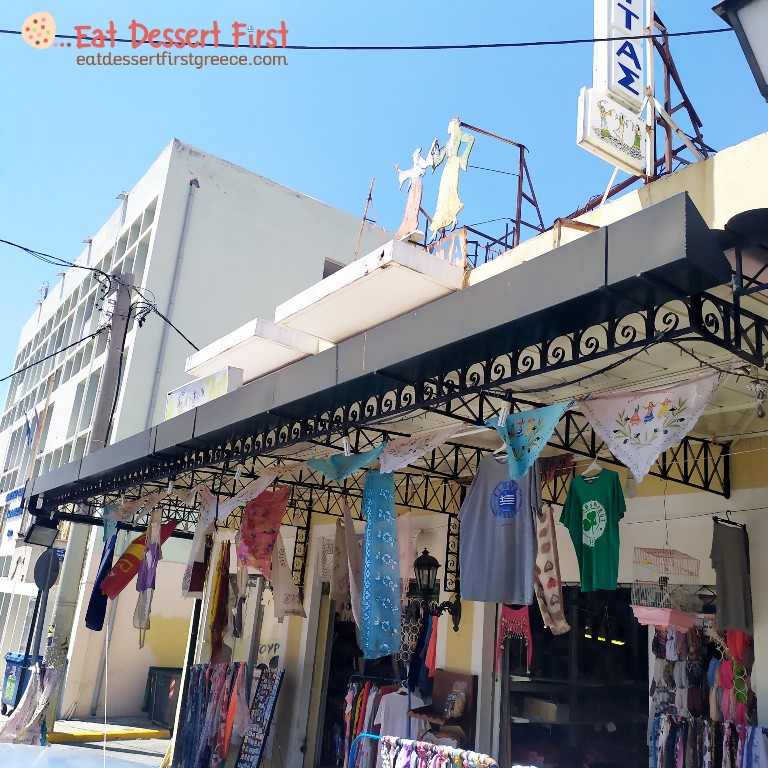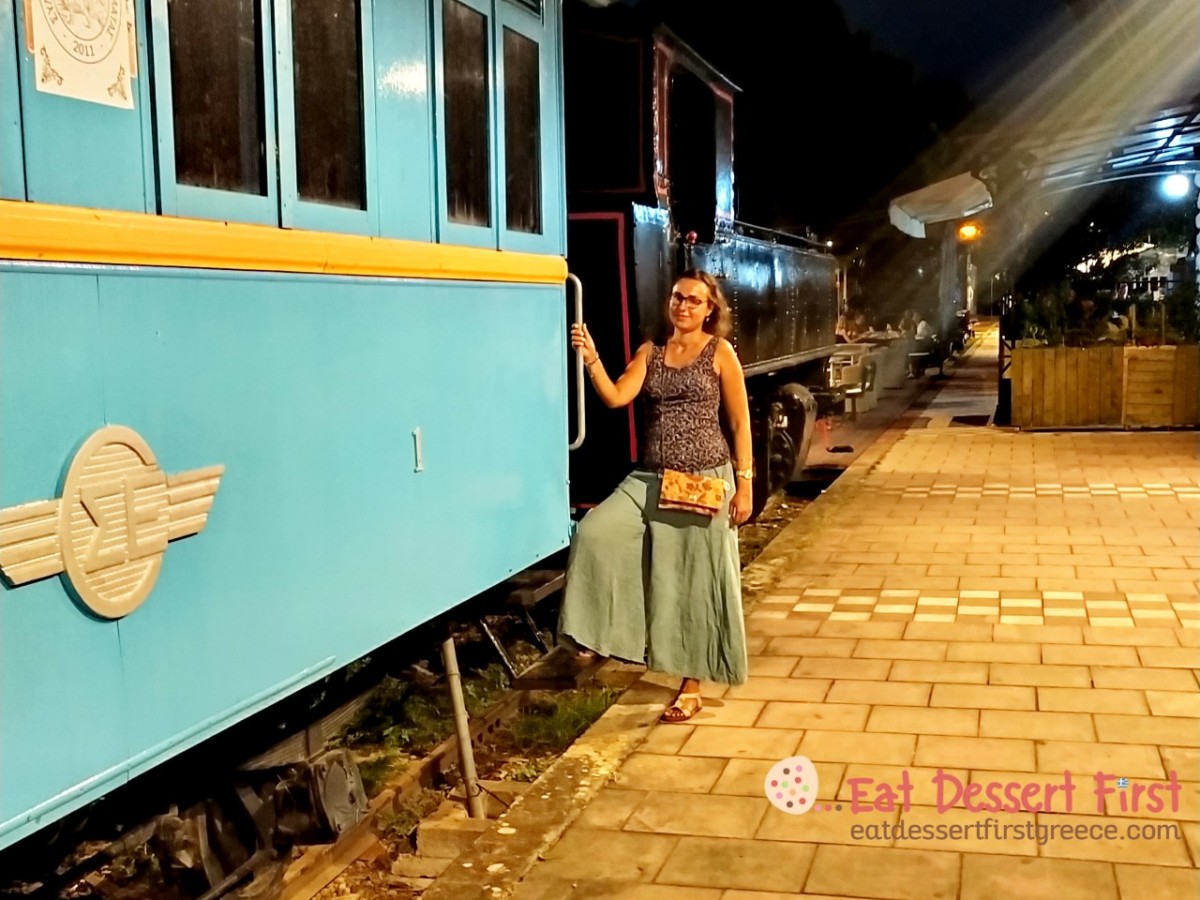See here the first part of our tribute to Kalamata.
In our last article we made a short trip to Ancient Messini and two nearby monasteries, the Monastery Voulkanou and the Holy Monastery of the Transfiguration of the Savior in the village of Monastiri (former Varybopi). We will start this article with this short trip.
The second part of our tribute to Kalamata begins with a swim in a slightly further sea, at Elea beach on the border of Messinia with Ilia. It continues with an evening walk in the historic center of Kalamata and a wonderful meal with creative dishes and cocktails. The next day starts with a delicious breakfast and a walk in the historic center of Kalamata in search of the famous Kalamata scarf. There we visit the church of Ypapanti, the Victoria Karelias Collection of Traditional Greek Costumes and the Military Museum of Kalamata. To end our trip beautifully and chilly, we make another trip to the impressive waterfalls of Polylimnio, before taking the road back to Athens.
Since we had already made a long way on our short trip to Ancient Messini and the nearby monasteries, we decided to swim on a beach relatively far from Kalamata, Elea beach. It was as they had described it to us… A vast sandy beach with a green pine forest behind it.



We read that Elea beach is the most northern beach of Messinia, at a distance of 10 km from Kyparissia, on the border with Ilia. The river Neda flows into this beach. We also learned that sea turtles lay their eggs on this beach every year, so the area is part of the protected areas of Trifylia.
With the green view of the pine forest we made our dive… The sea was warm with many big waves and it deepened quickly. The beach was endless, as it was in Kalamata, with golden sand, with a few pebbles as you enter the sea. On the beach there is a small beach bar from which you can get your coffee or drink, and a volleyball net for sand games.




The eye was lost on the one side in the blue of the sea and on the other in the green of the forest, a really beautiful experience. We kept in mind these wonderful images and got on the way back -a little less than an hour- to our base in Kalamata.
We returned to the hotel that hosted us, the Central Rooms in Vasileos Georgiou Square in Kalamata, to rest before our night out. Our room was waiting for us tidy and spotless to take our bath and sink for a while in its wonderful bed…

After resting and getting ready, we left for an evening walk in the historic city center. The historic center with its narrow streets, pedestrian streets and squares composes a beautiful setting, while the people who flood it make it vibrate with life. There the past coexists with the present, since now we could say that there beats the heart of the nightlife of the city. The historic center also has various attractions, cultural sites and museums, some of which we will visit the next day.





In the historic center one will find the historic church of the Holy Apostles, one of the most famous monuments associated with the Revolution of 1821, built during the Byzantine period. The doxology for the liberation of Kalamata, the first doxology in free territory, took place in this church on March 23, 1821. Kolokotronis, Papaflessas, Mavromichalis, Nikitaras and other heroes of the Revolution were present there.


After our short evening tour of the streets of the historic center of Kalamata, it was time for our dinner. We chose to visit the Platea restaurant in Vasileos Georgiou square, an elegant all-day cafe-bar-restaurant. The manager of the store, Giannis Spiliotis, told us that Platea serves from well-made coffee in the morning to selected drinks from around the world and cocktails made with the latest trends and techniques in the evening, as well as Mediterranean cuisine with international influences. As for the food, whether you choose brunch, snack, dessert or dish, the sure thing is that everything will be made with fresh, quality ingredients. We tried some of their typical dishes and we were impressed!


Its decoration, reminiscent of another decade’s Parisian alley, really makes it stand out. Its minimal tones and modern, beautiful aesthetic make it a landmark of the area that one must definitely visit. Its very beautiful and comfortable outdoor space and its impressive indoor space complement each other, and together with the quality food and the refreshing cocktails we tried, they offered us a truly unique experience.











After our wonderful dinner we returned to the room of our hotel, Central Rooms in Vasileos Georgiou square for a pleasant sleep. In the morning we had a wonderful breakfast in the cafe Kafein, which also belongs to the family business. With toasted sandwiches, eggs, praline, croissants, fruit salad with yogurt and cereals, waffles with praline and chocolate syrup, fresh orange juice and whatever coffee we wanted, it was exactly what we needed for the beginning of our day!



At noon we decided to take another urban walk in Kalamata. Kalamata is a city with many pedestrian streets, wide sidewalks and bike paths, ideal for walking tours, but also for cycling. It is also very important that there are everywhere ramps for the disabled on the sidewalks.
What we wanted to do now was to find the famous Kalamata scarves. We wandered for a while in the alleys of the historic center and finally found them in a store near the Metropolitan Church of Ypapantis.
And of course we had to read about their story. We found that the raw material of the Kalamata scarf is silk, which for centuries was an important export product of the region. In the 19th century there were many factories in the city. The Monastery Kalograion, dedicated to Saints Constantine and Helen, was distinguished from its foundation at the end of the 18th century for the weaving of silks for liturgical vestments, tablecloths, curtains and especially the famous silk scarves. In the monastery during the 19th century there were a hundred apprentices. The nuns raised the silkworms on their own and produced 3 tons of silk a year! In the monastery one can see the remaining looms, which still work and make traditional Kalamata scarves.


Kalamata in general had become the first silk production center of the state and its famous fabrics were circulating everywhere. Today, the production of scarves in Kalamata may have decreased a lot and it may be a bit difficult to find an authentic silk scarf, but the tradition keeps it in its dances, most notably Kalamatianos, where the scarf facilitates the first dancer to make figures. We were told that some shops that still sell Kalamata scarves exist near the church of Ypapanti, and there we found them!


Since we were in the area, we sought to find out about the imposing temple we saw in front of us. From a brochure we learned that the church located in the old upper town of Kalamata is the church of Ypapanti of the Savior, the metropolitan church of Kalamata. It was founded in 1860 and inaugurated in 1873. It is built northwest of a former Byzantine church. Where there was the altar, a marble cross has been placed with the inscription “This plaque reminds of a sanctuary”. The temple is one of the primary cultural monuments of the city, which is visited by thousands of pilgrims throughout the year.



In the Holy Monastery there is also the miraculous icon of Panagia “Ypapanti”, in front of which many miraculous signs have taken place. The image was found in a miraculous way around 1770. We read that the place where it was buried was seen in a dream by a horseman of the Turkish pasha! Since then, many believers have invoked Her help and confessed Her miracles.


Continuing our evening walk to two museums in the historic center, a folklore and a war museum, we needed a cup of coffee to stimulate us. We took it and left for the museum part of our walk!




Among the various museums and cultural sites of the city, we chose to visit the Victoria Karelias Collection of Traditional Greek Costumes. The museum does not allow to take and publish photos, but they sent us an extensive text that describes important information about the exhibition, along with beautiful photos from inside the museum which we will be happy to publish.

In the text they sent us we read that the collection of the museum was created by Mrs. Victoria Karelia, who was a founding member and for a number of years president of the Lyceum of Greek Women of Kalamata. Initially it was a personal collection, the outcome of a collector’s effort of years. The collection was then admitted to the Lyceum of Greek Women in Kalamata and bears her name as a sign of recognition.
The Lyceum of Greek Women, as we read in the brochure of the exhibition, was founded in 1911 in Athens by the pioneer of women’s emancipation Kalliroi Parren. It aimed at preserving Greek traditions and at the upliftment and progress of Greek women. The Lyceum of Greek Women of Kalamata was founded in 1867 and deals with the teaching of Greek traditional dances and songs, as well as folklore publications and recordings. For all its activities it has been repeatedly awarded by state organizations and social organizations.

The Victoria Karelias Collection of Traditional Greek Costumes is one of the most complete collections of Greek clothing worldwide, with women’s and men’s clothing from all regions of Greece. There are also individual sets of accessories, such as gold-embroidered cloaks, oriental gold-plated cocoons and jewelry. These groups are autonomous and important ensembles of the collection.

The museum manager was kind enough to tell us a few things about the exhibition. He told us that the exhibits are all authentic and date from the middle of the 18th century. until the middle of the 20th century. He told us that there are three categories of women’s clothing, according to the folklorist Angeliki Hatzimichali, to which the three floors of the exhibition correspond. On the ground floor there are the costumes with the sigouni, a woolen sleeveless vest. Wool was the raw material of the rural population. On the second floor the populations with intense commercial activity have the kavadi, a long dress open from the front usually made with luxurious fabrics. The third floor hosts the evolution of the dress from its older type to the later European style dresses.


The collection is housed in a magnificent protected building, which we want to note has been shaped internally in the most modern museological ways. The visitor moves in the dark corridors having an experiential contact with the illuminated exhibits, in an overwhelming atmosphere. We were very impressed by a mobile showcase with clothes, which moves up the floors like an elevator and thus unifies the exhibition.

All captions are digitized and there is a tablet next to each showcase. In it one could read the description of the showcase and the exhibits in different languages, see photos from different sides of the exhibits and zoom in on whatever one wants. Now, due to the pandemic, each visitor receives his own portable tablet, which is disinfected after each use, to accompany him on his tour of the exhibition. It is a modern tour model, which utilizes technology in a way that supports the evolution of the museological meaning of the exhibition.
In the texts sent to us by the museum we also read that in the exhibition space there are educational programs for school classes of all levels, something that makes us very happy. Specialized tours for Greeks and foreign visitors are also organized, as well as music events, art exhibitions and other cultural activities that contribute to the multilevel promotion of the space -and to its “opening” to city life we will add.

We had a wonderful time in the Victoria Karelias Collection of Traditional Greek Costumes, but there was another place we wanted to visit, the Military Museum of Kalamata which was located nearby.
At the Military Museum of Kalamata we met the responsible permanent soldier, who was very kind and informative and spoke to us about the museum. He even gave us permission (after consultation with the superiors) to photograph and publish the exhibits of the museum and we thank him warmly!
We read that the Military Museum of Kalamata was founded in 2005. The building in which it is housed is the old Metropolis of Messinia, which was donated to the Army by the Metropolis. The two-storey building houses the permanent exhibition, which includes the modern military history of Greece from the Greek Revolution to the Invasion of Cyprus. Military vehicles and cannons are on display outside the museum.



At the museum we had the good fortune to attend to two different guided tours by two soldiers who did their service. They both gave us very detailed tours as they had a lot of historical knowledge to give us. The first tour was of more general interest, an oversight of the exhibition as a whole with stops at specific exhibits, while the second tour was more focused on rare exhibits not found in other military and war museums. The information conveyed to us by both guides was very interesting and exceeds the size of an article. That is why we will continue with some selected exhibits in photos…














We saw many other exhibits: (click for full view)
















We left the museum full of new knowledge and experiences and for that we warmly thank its people! We still had some time before returning to our base in Athens and this beautiful journey came to an end. So, we decided to make another small excursion to cool off at the waterfalls in the nearby Polylimnio in Haravgi, Messinia. After a forty minute drive we had arrived and at first glance we understood that it was worth it…

It is a beautiful place, where one can take a short hike to the ponds and swim in their cool water. In the green and in nature, you do not expect that you will find water somewhere and yet you find it! We had the courage to dive and we did not regret it at all! The water was cold and refreshing and together with the green view it was a unique experience. And because especially in terms of nature a picture is worth a thousand words we will let the natural beauties speak for themselves…
A photo reportage from Polylimnio Waterfalls:






(Click on the photos for full view)






























Somewhere here ends our seventh consecutive article from our trip to Mani and Kalamata… We saw beautiful places, met good people, ate delicious food, gained knowledge and experiences and now return to our base in Athens for new sweet adventures!
Be the first one to read our new articles!
Find us on our social media:
- Instagram: @eatdessertfirstgreece
- Facebook profile: Giorgos Eliza Vlachakis
- Facebook page: eatdessertfirstgreece
- Twitter: @eatdessert1stGr
- Pinterest: eatdessert1stGr
- WordPress: Eat Dessert First Greece
- LinkedIn: Eliza Neofytou
- Reddit: eatdessertfirstgr
Follow us by filling in your email in the field at the bottom of our website, so that every new article will be emailed to you as soon as it is released. Do not forget to confirm your registration, in the email that will come to you! 🤗 Those of you who are wordpress bloggers, just click follow.



The beach , just amazing. Happy Weekend.☀️🙏
LikeLike
Happy weekend! Thank you so much!!
LikeLiked by 1 person
The pictures and the place are just gorgeous. Thank you for this beautiful travel blog. 🙂
LikeLike
We are glad you like it and thank you very much for your beautiful words about our country and our blog! 🙏🏽🙏🏽❤️❤️
LikeLiked by 1 person
It’s my pleasure. I hope to visit Greece soon. My cousin and her family visited the country a few years back and they had a great time there. 🙂
LikeLike
We wish things to get better for everyone and to able to travel safe!! Thank you so much again and have a great Sunday!! 🙂🙂
LikeLiked by 1 person
An enjoyable visit – the beaches! the food! And my favorite olives.
LikeLike